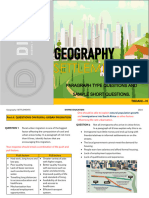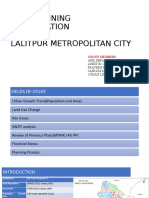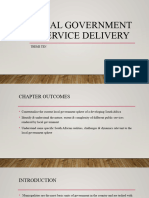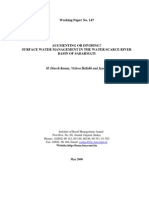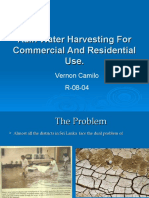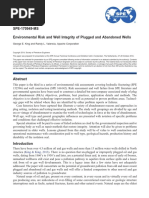Exam 2 Review
Exam 2 Review
Uploaded by
nibbles2Copyright:
Available Formats
Exam 2 Review
Exam 2 Review
Uploaded by
nibbles2Copyright
Available Formats
Share this document
Did you find this document useful?
Is this content inappropriate?
Copyright:
Available Formats
Exam 2 Review
Exam 2 Review
Uploaded by
nibbles2Copyright:
Available Formats
ARE 1110, Emma Bojinova
Population Distribution between Urban
Second Midterm Exam and Rural Areas
• Worth 80 pts.
• The same structure as before: 18 multiple- Urban Area: town or city (including adjacent suburbs)
choice Qs & 3 short answer questions with population of more than 2500
• Topics: Urbanization, Water, Soil + discussion 3
• Use the study guide as a guideline for the Degree of Urbanization: percentage of a region’s
topics/concepts that can be on the exam population that lives in urban areas
• Study buddies?
• Don’t forget to complete HW#3 and the two Urban Growth: rate of increase of urban
dynamic study modules populations
1 2
Why is urban population growing? Why is urban population growing?
Pop growth = births - deaths + immigration - emigration Over the recent years, urbanization has
slowed in MDCs and growing rapidly in
natural increase net migration LDCs.
Causes (for net migration):
• Pull factors - higher income jobs, education, health-
In developing countries, growth in
care, cultural opportunities urbanization is a consequence of ecological
degradation, industrialization, low availability
• Push factors - farm mechanization, government of jobs in rural areas, wars, and conflicts.
policies
3 4
Exam 2 Review Handout 1
ARE 1110, Emma Bojinova
Urbanization in the United States Urbanization in the United States
More than
• 82.46% of the population lives in urban areas, Current general migration patterns: 50% of US
occupying 3% of land (2019 data, World Bank) • from central cities to suburbs & small cities population
• from the North & East to the South & West is
https://data.worldbank.org/indicator/SP.URB.TOTL.IN.ZS suburban
https://www.statista.com/statistics/269967/urbanization-in-the-united-states/ • from urban areas back to rural areas
• Almost half of the population lives in metropolitan
areas containing 1 million or more people
Major improvements: better work conditions,
medical care, & environmental quality since 1920
Remaining problems of big cities:
• inner-city poverty, crime, infrastructural decay
• road congestion & auto pollution, disappearing open-
space
5 6
Sprawl Urban Sprawl & Its Characteristics
• Sprawl is the spread of low-density urban, Urban sprawl
suburban, or exurban development out from Causes: A combination of cheap gasoline, plentiful
an urban center. land, & a network of highways produces dispersed,
automobile–oriented cities with low population density
Other characteristics
• single family housing - high cost of insulation
• limited (or non-existent) public transportation -
residents must drive to work, services, & recreational
facilities
Consequences
7
• increased congestion, loss of open-space, pollution,
global warming, & nonrenewable resource use
7 8
Exam 2 Review Handout 2
ARE 1110, Emma Bojinova
Urban Sprawl & Its Characteristics Urban Sprawl & Its Characteristics
Impacts of sprawl in more detail Impacts of sprawl in more detail
• Transportation – you need to own a car, more traffic • Land use – less left for forests, fields and farmland
accidents, dependence on non-renewable resources which provide vital resources, recreation, beauty,
such as petroleum wildlife habitat, air and water purification
• Pollution – carbon dioxide emissions from cars (global • Economics – use tax money for infrastructure for new
warming), nitrogen and sulfur air pollutants (smog and developments and not for making existing cities more
acid rain), runoff of polluted water (affects soil and beautiful and livable
waterways), motor oil and salt (risks to ecosystems)
• Health issues – increased physical inactivity (increase
obesity and high blood pressure)
9 10
Means of Transportation Which mode of transportation has lower
operation and roadway costs?
Individual transit
• includes cars, motorcycles, bicycles, walking
• in U.S., cars are used for over 90% of travel to work
Mass transit
• includes subways, trains, buses, airplanes
• constitutes 5% of travel in U.S., 15% in Germany, 47%
in Japan
11 12
Exam 2 Review Handout 3
ARE 1110, Emma Bojinova
Mass Transit in the U.S. City and Regional Planning
Some government tax policies that favor cars Regional Planning – broader geographic scale,
may coordinate work with multiple municipal
• 70% of federal gas tax goes to highways
governments
• parking expenses incurred by employers are tax
deductible • Zoning – a key tool for planning
Classifying areas for different types of
Possible ways of favoring mass transit development and land use – residential,
• higher taxes on cars (or gasoline) commercial
• road-pricing (see Economist article “Living with the • Setting urban growth boundaries (UGBs) – reduce the
Car”) costs of infrastructure compared with sprawl –
estimated 20% savings for taxpayers; preserving
• greater subsidies for mass transit, less for cars farms and forests (increased urban density)
• more public investment in mass transit
13 14
“Smart” Growth Environmental Effects of Urban
Areas
• Set UGBs
Principles • Resource usage: Cities and towns are sinks for resources –
• Mix land uses
“import” almost everything they need (food, water, timber,
Greenways and greenbelts fiber, ores, fuels, etc.) and need land for water and air
• Encourage compact building design purification, waste disposal, nutrient cycling
• Create walkable neighborhoods (“new urbanism”) • Efficiency – concentration of people allows for more
efficiency
Nearly 600 such communities in the US – transit-oriented
development, bicycle transportation • Consumption – cities take only 2% of the world’s land but
consume over 75% of its resources (might be related to
• Provide variety of transportation choices wealth)
• Preserve open spaces, farmland, natural beauty • Land use – preserves land
• Strengthen and develop existing communities • Pollution – air , water, noise, light, urban island heat effect
• Encourage shared decision-making
15 16
Exam 2 Review Handout 4
ARE 1110, Emma Bojinova
Uses of Fresh Water
Availability of Fresh Water
Worldwide
• Freshwater is only a small fraction of all water on earth • 70% agriculture (60%–80% of this not used by crops)
• Even less freshwater is readily available for human use • 20% energy production & industry
• 10% domestic & municipal use
Arid countries use more water for agriculture
Developed countries use more water for industry
United States
• 41% agriculture
• 38% energy production (power plant cooling) & 11%
industry (49% total)
• 10% domestic & municipal use
17 18
Aquifer Depletion
Human Activities Affect Waterways
• Aquifer depletion (or groundwater overdraft) occurs when
• Water is crucial for human health as well as farms and water withdrawals exceed recharge
factories
• Water is a limited but renewable resource • Groundwater in southern Great Plains and southwestern U.S.
• Withdrawal of water in most of the world is unsustainable is being withdrawn much faster than its replacement rate
– We are depleting many sources of surface water (e.g.
Aral Sea) and groundwater • Aquifer depletion is also a serious concern in other parts of the
world - e.g., southern Europe, Middle East, northern Africa,
– One-third of the world’s people are affected by water
India, northern China
shortages
• Fresh water and human populations are unevenly • Examples: Ogallala aquifer - withdrawals from the world’s
distributed across Earth largest aquifer exceed recharge rates by 8-10 times in many
• Fresh water is also unevenly distributed in time places
19 20
Exam 2 Review Handout 5
ARE 1110, Emma Bojinova
Possible Consequences of Aquifer Economics of Aquifer Depletion
Depletion
• Large depletable aquifers are typically common-
• Water Scarcity property resources
• Aquifer Subsidence - land sinks when water is
withdrawn • Over-exploitation occurs if users do not bear the full
social cost of extraction
• Saltwater Intrusion
• Need for government intervention depends on extent
of market failure
• Various policies can be designed to encourage water
conservation - taxes, quotas, other guidelines and
incentives
21 22
Management of Surface Water Scarcity
Surface water scarcity may be alleviated by:
• modifying local water allocation laws (or
doctrines) & creating incentives for conservation
• making regional water treaties & transfers
• building reservoirs and dams
Possible Advantages & Disadvantages
23 24
Exam 2 Review Handout 6
ARE 1110, Emma Bojinova
Reservoir Sedimentation and Its
Solutions to Depletion of Fresh Water
Consequences
• Reservoir storage capacity has decreased over • Our use of fresh water has doubled over the last 50 years.
time due to sedimentation We can either increase supply or reduce demand
• Consequences: less reliable water and power • Increasing supply through intensive extraction is only a
supply, shorter life of dams, lower economic temporary fix
benefits (hydropower, irrigation, flood control, – Diversions increase supply in one area but decrease it
municipal water supply) elsewhere
• Solutions: • Reducing demand is harder politically in the short term
• Prevention – International aid agencies are funding demand-based
• Removal (flushing, dredging, hydrosuction, solutions over supply-based solutions
trucking) – Offers better economic returns
• Structural accommodation (sediment traps, – Causes less ecological and social damage
expansion of storage) (see your lecture notes for more details)
25 26
Soil Horizons Soil Texture & Chemical Properties
O horizon (surface litter) - mostly fresh leaves,
animal waste, fungi and other organic materials Soil texture (porosity, permeability) helps determine
suitability of soil for agriculture (water & nutrient
A horizon (topsoil) - porous mixture of humus holding capacity, water infiltration capacity,
(partially decomposed organic matter) and inorganic workability)
minerals
Loam is soil with roughly equal parts of clay, sand,
E horizon (eluviated) – leaching layer (minerals and silt and humus - loam is ideal for growing most
organic matter tend to leach out of this horizon crops
• B horizon (subsoil) & C horizon (weathered parent • Uptake of soil nutrients by plants is reduced in
material) - mostly inorganic matter, with varying acidic soils (pH value below 5.5)
mixture of silt, sand, clay, and gravel
• R horizon – rock parent material
27 28
Exam 2 Review Handout 7
ARE 1110, Emma Bojinova
Soil Erosion & Its Consequences Types of Soil Erosion Caused by Water
• Soil erosion is the movement of soil components, • Sheet erosion - uniform layers (sheets) of soil are
especially litter & topsoil, from one place to another peeled off across a field
• The agents of erosion are wind and/or flowing
• Rill erosion - fast flowing water cuts small
water channels in soil
• Losing topsoil makes soil less fertile & less able to
hold water • Gully erosion - extreme form of rill erosion in
• Sediment is also a major water pollutant which small channels merge and become deeper to
form gullies and ditches
29 30
Desertification Soil Erosion - Solutions
• Desertification of • Land reclamation
arid & semi-arid
lands results when reforestation, gully reclamation
land productivity • Prevention
drops by at least
10% take vulnerable lands out of production,
practice soil conservation
• moderate: 10 - 25%
• severe: 25 - 50%
• very severe: more
than 50% The process by which fertile land becomes
desert, typically as a result of drought,
deforestation, or inappropriate agriculture.
31 32
Exam 2 Review Handout 8
ARE 1110, Emma Bojinova
Soil Conservation Measures
• Conservation–tillage farming minimizes soil
disturbance (leaving previous year crop residue)
incl. no-till farming
• Crop rotation – rotating crops - restores nutrients
and also reduces soil erosion
• Terracing protects steep slopes
• Contour farming follows natural land contours on
gentle slopes
• Strip cropping or intercropping maintains strips of
different vegetation between crops
• Windbreaks or shelterbelts protect against wind
erosion
(see your lecture notes & text for more details)
33 34
Other Problems of Irrigation: Soil Salinization &
Waterlogging
• Soil salinization -
irrigation water carries
salts which may build
up to levels that
decrease yields or
prevent cultivation
• Waterlogging -
excessive irrigation
water raises the water
table & lowers crop
productivity
35
Exam 2 Review Handout 9
You might also like
- Rural VS Urban Characteristics FinalDocument14 pagesRural VS Urban Characteristics FinalVarunNo ratings yet
- Submersible Pump Simulation For WaterGEMS - OpenFlows - Hydraulics and Hydrology Forum - OpenFlows - Hydraulics and Hydrology - Bentley CommunitiesDocument3 pagesSubmersible Pump Simulation For WaterGEMS - OpenFlows - Hydraulics and Hydrology Forum - OpenFlows - Hydraulics and Hydrology - Bentley Communitiesبلال بن عميرهNo ratings yet
- CE3141 Module 2021-22Document85 pagesCE3141 Module 2021-22Asus LaptopNo ratings yet
- Town Planning Problems in Urban AreasDocument22 pagesTown Planning Problems in Urban Areasnivedita2020No ratings yet
- SWOT Analysis Report: Goshen Master Plan Update January 31, 2011Document3 pagesSWOT Analysis Report: Goshen Master Plan Update January 31, 2011ShaliniNo ratings yet
- GEO Yr 8 UrbanisationDocument15 pagesGEO Yr 8 UrbanisationTessNo ratings yet
- UrbanizationDocument81 pagesUrbanizationmalaitaman0% (1)
- 1.7 Urbanisation_ Ko_ Theme 1Document5 pages1.7 Urbanisation_ Ko_ Theme 1afreenahmadNo ratings yet
- Training Camp CC Power Point - May 15Document50 pagesTraining Camp CC Power Point - May 15api-27519687No ratings yet
- Lagos and Urban ChallengesDocument3 pagesLagos and Urban Challengesandas.kriegerNo ratings yet
- Suburbanisation and Counter UrbanisationDocument2 pagesSuburbanisation and Counter Urbanisation3alliumcourt100% (1)
- CH 11 Urbanization and Sustainable CitiesDocument34 pagesCH 11 Urbanization and Sustainable Citiessabymohx97No ratings yet
- Eees 1130_lec 26_urbanization (Fall, 2023)Document46 pagesEees 1130_lec 26_urbanization (Fall, 2023)bhollabaugh99No ratings yet
- Overall Content Revision Paper 2Document28 pagesOverall Content Revision Paper 2muhammedkakar8912No ratings yet
- Town Planning: UrbanizationDocument30 pagesTown Planning: UrbanizationGurpreetSinghKalsiNo ratings yet
- Kuliah 14 SI 5243 SUT 2023Document153 pagesKuliah 14 SI 5243 SUT 2023muslina syahrilNo ratings yet
- Settlement Geography - Questions To ExpectDocument11 pagesSettlement Geography - Questions To ExpectTodani nzumbululoNo ratings yet
- Module 1 - Urban Planning - 2021-1Document150 pagesModule 1 - Urban Planning - 2021-1SREYAS K MNo ratings yet
- Urban IssuesDocument2 pagesUrban Issueschemphycomb100% (2)
- Housing Mod3Document23 pagesHousing Mod3faheem momdNo ratings yet
- 3a056fDocument5 pages3a056fsoftfedblogNo ratings yet
- UrbanisationDocument10 pagesUrbanisationManas GuptaNo ratings yet
- Sustainable CityDocument72 pagesSustainable CityHayoun MohammedNo ratings yet
- 1. World Cities Knowledge OrganisersDocument1 page1. World Cities Knowledge Organisershheshini12No ratings yet
- Cls 9 EVS Mod 3 On UrbanisationDocument2 pagesCls 9 EVS Mod 3 On UrbanisationItu DeyNo ratings yet
- 03 Causes of Rapid Urban Growth LIDCsDocument11 pages03 Causes of Rapid Urban Growth LIDCsiGotheInfoNo ratings yet
- Perumahan Rakyat 1 Malaysia National Housing Program: 24 May 2016 Presentation To Fspu, Uitm Shah AlamDocument63 pagesPerumahan Rakyat 1 Malaysia National Housing Program: 24 May 2016 Presentation To Fspu, Uitm Shah Alamrahdy850117No ratings yet
- Foda de Comas: - Jose Leyva Sinche - German Castro Barrientos - Alex Jauregui PallaDocument19 pagesFoda de Comas: - Jose Leyva Sinche - German Castro Barrientos - Alex Jauregui PallaScribdTranslationsNo ratings yet
- Urbanization and Rural-Urban Migration: Theory and Policy: by Group 3Document40 pagesUrbanization and Rural-Urban Migration: Theory and Policy: by Group 3ARYAT100% (3)
- PPTDocument26 pagesPPTraziakhatun542No ratings yet
- Data RelatedDocument5 pagesData RelatedGhanshyam BairwaNo ratings yet
- Primate Cities and The Rank-Size RuleDocument21 pagesPrimate Cities and The Rank-Size Ruleapi-369449529No ratings yet
- Aldous 1998 - Urban VillagesDocument2 pagesAldous 1998 - Urban VillagesNeil SimpsonNo ratings yet
- SOPY 3005 - Lecture 03Document24 pagesSOPY 3005 - Lecture 03chanchunsumbrianNo ratings yet
- URBANIZATIONDocument28 pagesURBANIZATIONJohn Paul De LunaNo ratings yet
- URBANIZATIONDocument28 pagesURBANIZATIONAlyanna Pauline GomezNo ratings yet
- Telematics Paper 2 2023Document26 pagesTelematics Paper 2 2023Chantel DimaNo ratings yet
- City Planning Presentation On Lalitpur Metropolitan CityDocument27 pagesCity Planning Presentation On Lalitpur Metropolitan CityAnkit Kumar ShahNo ratings yet
- New IGCSE UrbanDocument14 pagesNew IGCSE UrbanSuheng WangNo ratings yet
- Adi Innercity RedevelopmentDocument65 pagesAdi Innercity RedevelopmentBereket K50% (2)
- Urban and Regional Economy Gees 516: Chapter OneDocument142 pagesUrban and Regional Economy Gees 516: Chapter OneGetuNo ratings yet
- Lesson OneDocument28 pagesLesson Oneveeveepatrick1No ratings yet
- Bahira-Trask-Urbanization-Trends-Around-The-World-Regional-Perspectives-And-Approaches-And-Linkages-With-FamiliesDocument39 pagesBahira-Trask-Urbanization-Trends-Around-The-World-Regional-Perspectives-And-Approaches-And-Linkages-With-Familiesyouthhub852No ratings yet
- URBANISATIONDocument8 pagesURBANISATIONFavour Bee Z KatNo ratings yet
- Urban AreaDocument9 pagesUrban AreaIrraz Bin Idris100% (1)
- Day 18 PDFDocument25 pagesDay 18 PDFჯონ ფრაატეეკNo ratings yet
- Theme TenDocument16 pagesTheme TenxhjqbhtygqNo ratings yet
- Economic Development Module 7-11Document39 pagesEconomic Development Module 7-11Althea mary kate MorenoNo ratings yet
- 3pm Urban Problem in OdishaDocument10 pages3pm Urban Problem in Odishaadhikari9528No ratings yet
- HSTP (3. Urbanization) - 0ee53a0a 30dc 45bf Ad21 Fa99df9037d0Document9 pagesHSTP (3. Urbanization) - 0ee53a0a 30dc 45bf Ad21 Fa99df9037d0neshasheiks.7No ratings yet
- Urban Expansion and DevelopmentDocument9 pagesUrban Expansion and DevelopmentAMAN KUMARNo ratings yet
- Urban SprawlDocument22 pagesUrban SprawlBharat NihalaniNo ratings yet
- UrbanImprovementRenewalandEvolutiongeofile490 PDFDocument11 pagesUrbanImprovementRenewalandEvolutiongeofile490 PDFMahamed AbdulahiNo ratings yet
- Compact City: Sustainability ConceptsDocument28 pagesCompact City: Sustainability Conceptsvandy nehalia100% (1)
- 2. F3SS_Migrant Workers SVDocument34 pages2. F3SS_Migrant Workers SVOwen LiNo ratings yet
- Module 3-4Document26 pagesModule 3-4JisniNo ratings yet
- Future of Addis Ababa 2021 Addis Ababa S Strategic Development FrameworkDocument120 pagesFuture of Addis Ababa 2021 Addis Ababa S Strategic Development Frameworkcrafts with daniNo ratings yet
- Urban Issues and Challenges RevisionDocument9 pagesUrban Issues and Challenges RevisionSNo ratings yet
- Urban and Rural Communities: Almodovar, Marco Sia, Aaron Joseph A. Bsat-4ADocument22 pagesUrban and Rural Communities: Almodovar, Marco Sia, Aaron Joseph A. Bsat-4AJomel BaptistaNo ratings yet
- Scenarios - Bedroom CommunityDocument9 pagesScenarios - Bedroom CommunitysiguwNo ratings yet
- Gentrification and Displacement Process: A Case Study of ErbilFrom EverandGentrification and Displacement Process: A Case Study of ErbilNo ratings yet
- Virtual Lab-Water QualityDocument6 pagesVirtual Lab-Water Qualityapi-264228415No ratings yet
- River Rules 2012Document3 pagesRiver Rules 2012bigrjsNo ratings yet
- Civil Vi Environmental Engineering I (10cv61) NotesDocument142 pagesCivil Vi Environmental Engineering I (10cv61) NotesPoojit Popli100% (1)
- ELP Project ReportDocument28 pagesELP Project ReportNikhil AbrahamNo ratings yet
- Family Nursing Analysis LatestDocument143 pagesFamily Nursing Analysis LatestLyca Mae AurelioNo ratings yet
- Imphal EasaaDocument1 pageImphal EasaaKosygin LeishangthemNo ratings yet
- 765 65445Document31 pages765 65445Joshi DhvanitNo ratings yet
- Chatterjee 1999, Calcutta, U, RSDocument11 pagesChatterjee 1999, Calcutta, U, RSVinay ChaudharyNo ratings yet
- 3 Lanka Rain Water Harvesting ForumDocument15 pages3 Lanka Rain Water Harvesting ForumVernon CamiloNo ratings yet
- 6 Seepage Force Considerations in Tunnelling PDFDocument7 pages6 Seepage Force Considerations in Tunnelling PDFbiles1234No ratings yet
- Handbook On DevelopmentBuilding Works in RailwayProtectionZone PDFDocument108 pagesHandbook On DevelopmentBuilding Works in RailwayProtectionZone PDFPcEngNo ratings yet
- 1.1 General: Department of Civil Engineering, MIT MYSOREDocument26 pages1.1 General: Department of Civil Engineering, MIT MYSOREThanuj MurthyNo ratings yet
- Final Report Executive SummaryDocument23 pagesFinal Report Executive SummaryROMIELYN NAZARENONo ratings yet
- Groundwater Quality AnalysisDocument115 pagesGroundwater Quality AnalysisDr. Surendra Kumar Chandniha100% (2)
- Ground Water Geology of KordofanDocument53 pagesGround Water Geology of KordofanBUSHRA_KHARIFNo ratings yet
- The Trouble of WaterDocument1 pageThe Trouble of Waters236576No ratings yet
- Impact of Climate Change On Groundwater SystemDocument49 pagesImpact of Climate Change On Groundwater SystemMahmoud I. MahmoudNo ratings yet
- Emrald Mall, LucknowDocument32 pagesEmrald Mall, LucknowSushma SharmaNo ratings yet
- Norwegian HPP TunnelsDocument134 pagesNorwegian HPP TunnelsCésar OrbeNo ratings yet
- Stability With Perched Water TableDocument5 pagesStability With Perched Water TableJavier Andres Martinez OrtegaNo ratings yet
- SPE-170949-MS Environmental Risk and Well Integrity of Plugged and Abandoned WellsDocument17 pagesSPE-170949-MS Environmental Risk and Well Integrity of Plugged and Abandoned WellsMohammedNo ratings yet
- Water and Wastewater References, Models, and Terminology: 3.1 Setting The StageDocument10 pagesWater and Wastewater References, Models, and Terminology: 3.1 Setting The StageAymene Salah BendrihemNo ratings yet
- Chamrajanagara StatisticsDocument183 pagesChamrajanagara Statisticsjanardhan HSNo ratings yet
- River Sea Systems Actors and Events For Science Developments Relevant For The Innovation Process of DANUBIUSDocument145 pagesRiver Sea Systems Actors and Events For Science Developments Relevant For The Innovation Process of DANUBIUSAndreea ElisaNo ratings yet
- Major Environmental Management LawsDocument14 pagesMajor Environmental Management LawsMARK JUN M. BALTAZARNo ratings yet
- Cbse Class 10 Science Notes Chapter 16 Sustainable Management of Natural ResourceDocument5 pagesCbse Class 10 Science Notes Chapter 16 Sustainable Management of Natural ResourceRajnesh vanavarajanNo ratings yet
- Clase 11 Hydraulic Testing Fractured RocksDocument24 pagesClase 11 Hydraulic Testing Fractured RocksRizani MuhaiminNo ratings yet
- EIA BurigangaDocument14 pagesEIA BurigangaArif Reza TamalNo ratings yet
















